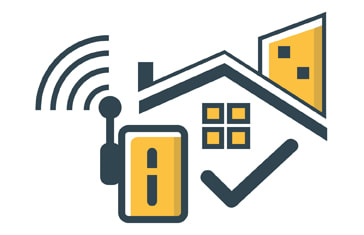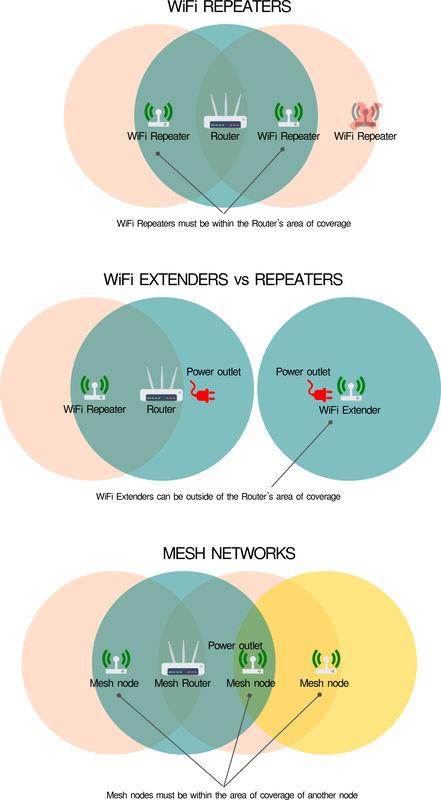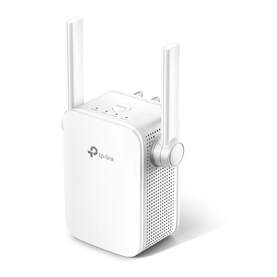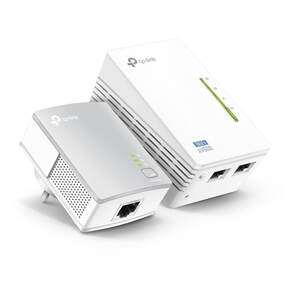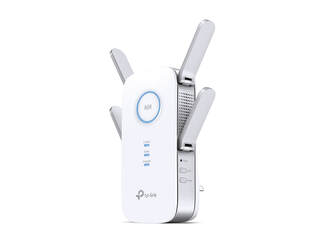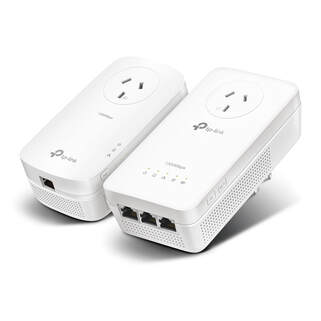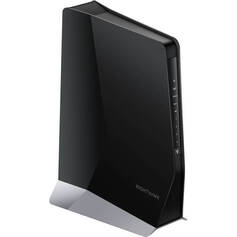Best Wifi Extenders 2024 - The Definitive Guide to Buying a WiFi Extender
Our guide explains the difference between WiFi boosters, repeaters and extenders, and showcases the best 10 available right now.
Updated 3 January 2024
In this guide we explain WiFi extender options, the best WiFi extenders and must-know tips. We cover:
Types of WiFi Extender
Most manufacturers use the terms WiFi repeater, WiFi booster, Mesh Range Extender, and WiFi extender (aka Range Extender) interchangeably to refer to devices that improve WiFi coverage. That might lead to confusion, so let's take a closer look at the meaning of these terms:
- WiFi Booster. Formally speaking any device that extends your wireless coverage may be called WiFi booster, so you can think of “WiFi boosters” as the parent category for this kind of devices.
- WiFi Repeater. This type of WiFi booster usually pick up the signal of your WiFi router and then retransmit it hence its name.
- WiFi Extender. In the case of WiFi extenders, they connect to your router through a wired connection and then retransmit the WiFi signal wirelessly.
- Mesh Range Extender. This is a relatively new technology that extends the wireless signal through the use of “nodes”
WiFi RepeaterWiFi repeaters are the most basic WiFi signal booster currently available.
How do they work? WiFi repeaters connect to your WiFi network wirelessly, similarly to any other device, and then rebroadcast your router signal. In theory, this simple solution is all you need to extend your signal and eliminate annoying dead spots. However, there are some issues associated with this technology. Since most WiFi repeaters use the same band to receive and transmit the WiFi signal, in practice they reduce the available bandwidth by half for all the devices connected to them. Moreover, since they connect to your router wirelessly, they must have a strong signal, otherwise, they would not be able to transmit. WiFi Repeater Highlights:
WiFi Repeater - What We Like:
WiFi Repeater - What We Dislike:
|
WiFi ExtenderContrary to WiFi repeaters, WiFi extenders do not connect to your router wirelessly.
How do they work? WiFi extenders connect to your router through a wired connection, usually by means of ethernet or power line cables. This approach brings some benefits. First of all, since wired connections are far more reliable than their wireless counterpart, WiFi extenders can rebroadcast a strong and stable signal. The hybrid wired/wireless nature of WiFi extenders allows them to provide full bandwidth to the devices connected to them since they use their wireless radio exclusively to transmit. Furthermore, WiFi extenders are not affected by walls or obstacles like WiFi repeaters, meaning you have more flexibility to locate them around your home or office. In the case of Powerline extenders, all you have to do is to plug an adapter into your modem or router and then plug the extender to an electrical outlet of your choice. WiFi Extender Highlights:
WiFi Extender - What We Like:
WiFi Extender - What We Dislike:
|
Mesh Range ExtenderMesh networks are without a doubt the future. They combine so many benefits that it is only a matter of time before they become the new standard. However, like all new technology, they are very expensive and therefore not as common as conventional WiFi networks.
How do they work? This special type of network is based on the concept of nodes that "talk" to each other wirelessly. In mesh systems, one of the nodes connects to the internet and passes the signal to the other nodes, which in turn distribute it to others, and so on. Therein lies the main difference of mesh networks with conventional systems. In traditional systems, range extenders must always be connected directly to the router to obtain the internet signal. Not in mesh systems. Each node works as a receiver and transmitter at the same time. This allows multiple nodes to communicate in a chain, allowing the signal to be extended almost infinitely by adding more nodes. WiFi Mesh Range Extender Highlights:
WiFi Mesh Range Extender - What We Like:
WiFi Mesh Range Extender - What We Dislike:
|
Key Factors to Consider When Buying a WiFi Extender
Below is a curated list of the key factors you should keep in mind when buying a WiFi extender. While some aspects might seem subjective (as ease of use) others like the type of extender are so crucial that we suggest to do not overlook any of them.
- Type of WiFi booster. For the purpose of this guide, we will classify WiFi booster into repeaters, extenders, or mesh range extenders.
- Recommended usage. Depending on its speed and type, some WiFi booster might not be ideal for gaming or streaming services like Netflix
- Wireless speed. This is one of the key aspects to consider (along with the type of booster). The faster the better.
- Ports. The number of ports may or may not be a deal-breaker for you. For instance, if you plan to use the WiFi extender to connect your SmartTV then it could be a good idea to do it through an ethernet cable. The same goes true for gaming consoles and other peripherals that benefit from stable wired connections.
- Ease of use. Some WiFi boosters require you to log in into their web interface to configure them, some only require using WPS buttons. We suggest choosing units that provide both methods.
- Bands. You should pay special attention to this factor. We strongly suggest choosing WiFi repeaters/extenders using the same bands as your router. For example, if your router uses a dual-band design, then pick a dual-band booster. If your router uses a tri-band design choose a tri-band booster. This ensures you will make the most out of your connection speed.
- Number of antennas. The more the merrier. Usually, more antennas indicate a greater range and/or number of bands
- Wireless security. Always pick WiFi boosters with the most current wireless security standards.
- Dimensions. While this aspect is many times overlooked, it is always a good idea to check the available space in your bedroom or living room, especially close to the power outlet
- Power consumption. Prefer devices with eco modes that control power when not in use.
Five of the Best WiFi Extenders Available in New Zealand Right Now
Choosing the best WiFi extender currently available in New Zealand is not an easy task. We have compiled our list (in no particular order) based on average consumer reviews collected from consumer.org.nz as well as other sources both in New Zealand and overseas.
1. Best Budget WiFi Repeater - TP-Link AC750 Wi-Fi Range Extender (RE205)
More details: TP-Link AC750 Wi-Fi Range Extender (RE205)
Pricing: From $68
Pricing: From $68
What We Like |
What We Dislike |
|
|
If all you need is to increase the range of your WiFi network in specific areas of your home or office without spending a fortune, then the TP-Link RE205 is an excellent option. Its compatibility with the 802.11ac standard and its dual-band design allows it to reach theoretical speeds up to 750Mbs which makes it suitable for activities such as web browsing, watching YouTube videos, and more. One aspect that made us select this particular model, is its compatibility with TP-Link's OneMesh technology. When used in combination with a companion OneMesh router, this technology allows the repeater to share a single WiFi network name (similarly to mesh network) eliminating the broadcasting issues of having two separate WiFi names.
Type of WiFi booster. WiFi Repeater
Recommended usage. Light video streaming, web browsing, music streaming
Wireless speed. Up to 750 Mbps
Ports. 1 x 10/100M Ethernet Port (RJ45)
Ease of use. Very easy. Can be set up using WPS buttons
Bands. Dual-band, 2.4GHz band (300Mbps) and 5GHz band (433Mbps)
Number of antennas. 2 x external
Wireless security. 64/128-bit WEP, WPA-PSK / WPA2-PSK
Dimensions. 80 x 78 x 77mm
Power consumption. 7.3W(max power consumption)
Type of WiFi booster. WiFi Repeater
Recommended usage. Light video streaming, web browsing, music streaming
Wireless speed. Up to 750 Mbps
Ports. 1 x 10/100M Ethernet Port (RJ45)
Ease of use. Very easy. Can be set up using WPS buttons
Bands. Dual-band, 2.4GHz band (300Mbps) and 5GHz band (433Mbps)
Number of antennas. 2 x external
Wireless security. 64/128-bit WEP, WPA-PSK / WPA2-PSK
Dimensions. 80 x 78 x 77mm
Power consumption. 7.3W(max power consumption)
Runner-up: TP-Link RE200 Dual-Band AC750 - From $68
If you are not interested in TP-Link’s OneMesh feature, you can purchase the RE200 which shares the same specifications of the RE205 at a lower price
- More details: TP-Link RE200 Dual-Band AC750
2. Best Budget WiFi Extender: TP-Link WiFi N300 Powerline Extender Kit (TL-WPA4220KIT)
More details: TP-Link WiFi N300 Powerline Extender Kit (TL-WPA4220KIT)
Pricing: From $108
Pricing: From $108
What We Like |
What We Dislike |
|
|
The Tp-Link WPA4220 is a true WiFi extender that thanks to the HomePlug AV2 standard can be used anywhere, as long as it has an available power plug. This means that it can be used to easily expand both the wireless and wired networks. However, this particular model sacrifices a lot to achieve its affordable price. On the one hand, it uses a single 2.4GHz wireless band, which limits its speed to 300Mbps. On the other hand, since it is not a pass-through model, it consumes two power outlets and an Ethernet port. Even with these notable disadvantages, its PowerLine technology and easy set up make this model ideal for locations that are too far away to use a conventional WiFi repeater, or have a weak router signal.
- Type of WiFi booster. WiFi Extender
- Recommended usage. Light music streaming, web browsing
- Wireless speed. Up to 300 Mbps
- Ports. 2 x 10/100M Ethernet Port (RJ45)
- Ease of use. Very easy. Can be set up using pair buttons
- Bands. Single-band, 2.4GHz band (300Mbps)
- Number of antennas. 1 x internal
- Wireless security. 64/128-bit WEP, WPA-PSK / WPA2-PSK
- Dimensions. TL-WPA4220: 54 × 40 × 94 mm, TL-PA411: 52 × 28.5 × 65 mm
- Power consumption. 7.6W(max power consumption)
3. Best Overall WiFi Repeater: TP-Link AC2600 Wi-Fi Range Extender (RE650)
More details: TP-Link AC2600 Wi-Fi Range Extender (RE650)
Pricing: From $199
Pricing: From $199
What We Like |
What We Dislike |
|
|
You can think of the TP-Link RE650 as the king of WiFi repeaters. It supports wireless speeds up to 800Mbps on the 2.4Ghz band and up to 1733Mpbs on the 5Ghz band plus Gigabit speed on wired connections. Also, the RE650 can extend WiFi coverage by up to 1,300 m2 thanks to its advanced microprocessor and its ultra-powerful signal strength. Moreover, this incredible device has the ability to transfer data simultaneously to multiple devices thanks to its four antennas and its MIMO capacity. These features added to its Beamforming Technology allows it to minimize most of the problems associated with WiFi repeaters, making it the ideal choice for anyone requiring a repeater capable of handling bandwidth-intensive applications such as 4K video streaming.
- Type of WiFi booster. WiFi Repeater
- Recommended usage. 4K streaming, gaming, and other demanding online applications
- Wireless speed. Up to 800Mbps on the 2.4Ghz band and up to 1733Mpbs on the 5Ghz band
- Ports. 1 x 10/100/1000M Gigabit Port (RJ45)
- Ease of use. Very easy. Can be set up using WPS buttons
- Bands. Dual-band, 2.4GHz band and 5GHz band
- Number of antennas. 4 x external
- Wireless security. 64/128-bit WEP, WPA-PSK / WPA2-PSK
- Dimensions. 163 x 86 x 40mm
- Power consumption. 12W(max power consumption)
Runner-up: TP-Link AC1750 Wi-Fi Range Extender (RE450) - From $97
Another great choice for anyone needing a high-speed WiFi repeater is the RE450. It only has 3 antennas, but still provides great coverage (up to 929 m2) and amazing speeds, up to 450Mbps on 2.4GHz band and 1300Mbps on 5GHz band
- More details: TP-Link AC1750 Wi-Fi Range Extender (RE450)
4. Best Overall WiFi Extender: TP-Link AC1350 WiFi Powerline Extender Kit (TL-WPA8630PKIT)
More details: TP-Link AC1350 WiFi Powerline Extender Kit (TL-WPA8630PKIT)
Pricing: From $299
Pricing: From $299
What We Like |
What We Dislike |
|
|
Do not let the speed of the WPA8630 WiFi Extender fool you. Remember that its 1350Mbps are entirely used for wireless transmission since it receives the signal from the router through its Powerline technology. This added to its dual-band 2X2 MIMO and Beamforming technology makes it an excellent choice for anyone who needs lag-free gaming and 4K streaming. Moreover, the Auto-Sync feature of the WPA8630 let you "clone" WiFi settings meaning that you can add more Powerline WiFi extenders and synchronize network settings across them with a touch of a button. Last but not least, its clever design with three Gigabit Ethernet ports and Passthrough Power Socket makes this unit perfect for connecting gaming consoles, SmartTVs, and other devices that require reliable, hi-speed connections.
- Type of WiFi booster. WiFi Extender
- Recommended usage. 4K streaming, gaming, and other demanding online applications
- Wireless speed. Up to 300Mbps on the 2.4Ghz band and up to 867Mpbs on the 5Ghz band
- Ports. 3 x 10/100/1000M Gigabit Port (RJ45)
- Ease of use. Very easy. Can be set up using pair buttons
- Bands. Dual-band, 2.4GHz band and 5GHz band
- Number of antennas. 2 x internal
- Wireless security. 64/128-bit WEP, WPA-PSK / WPA2-PSK
- Dimensions. TL-WPA8630P: 152 x 75 x 42mm, TL-PA8010P: 131×72×42 mm
- Power consumption. 10.8W(max power consumption)
5. Best Overall Mesh Range Extender: NETGEAR AX6000 Nighthawk AX8 WiFi 6 Mesh Extender
More details: NETGEAR AX6000 Nighthawk AX8 WiFi 6 Mesh Extender
Pricing: From $599 (when in stock)
Pricing: From $599 (when in stock)
What We Like |
What We Dislike |
|
|
If what you want is the best mesh range extender currently available in New Zealand then the NETGEAR Nighthawk AX8 is for you. It is certainly expensive, however, is loaded with all the bells and whistles that recent wireless technology can offer. In addition to being compatible with mesh networks, this incredible range extender is also WiFi 6 compliant, the latest and most advanced WiFi standard. That alone would make up for its cost, but there is more. The AX8 combines the exhilarating speeds of WiFi 6 with the MIMO technology meaning you can comfortably seat in your living room and watch ultra-HD 4K movies while your kids play games online and browse content from their smartphones or tablets. All at the same time with no lags. Furthermore, as part of a mesh network, the AX8 uses the same WiFi name, adding the convenience of using a single network name for your entire home or office.
- Type of WiFi booster. Mesh Range Extender
- Recommended usage. ultra-HD 4K/8K streaming, gaming, and other demanding online applications
- Wireless speed. Up to 1.2Gbps on the 2.4GHz and up to 4.8Gbps on the 5Ghz band
- Ports. 4 x 10/100/1000M Gigabit Port (RJ45)
- Ease of use. Very easy. Can be set up using WPS buttons, Netgear web interface, or free Nighthawk App
- Bands. Dual-band, 2.4GHz band and 5GHz band
- Number of antennas. 4 x internal
- Wireless security. 64/128-bit WEP, WPA-PSK / WPA2-PSK
- Dimensions. 279 x 197 x 106mm
- Power consumption. 10.8W(max power consumption)
Runner-up: NETGEAR NightHawk X6 EX7700 - From $328.99
While it is true that the NightHawk X6 does not provide the jaw-dropping speeds of WiFi6, at least it offers an affordable alternative to the AX8 mesh range extender
- More details: NETGEAR NightHawk X6 EX7700
Frequently Asked Questions
How do I choose the right WiFi extender for my needs?
It is important to consider the size of the area you need to cover and the number of devices connected to the extender. You should also consider the type of WiFi extender you need, such as a plug-in extender, desktop extender, or outdoor extender. Additionally, you should consider the speed and frequency of the WiFi network and the compatibility with your existing WiFi router. Our guide walks you through the best options for a range of needs.
Can a WiFi extender be used with any WiFi router?
WiFi extenders are typically designed to be compatible with most WiFi routers. However, it is important to check the compatibility of the WiFi extender with your existing router before purchasing. Some WiFi extenders may be designed to work with specific brands or models of WiFi routers.
Can multiple WiFi extenders be used with the same WiFi network?
Yes, multiple WiFi extenders can be used with the same WiFi network to extend the network's coverage further. However, you'll need to check the WiFi extenders are properly configured and in harmony with each other to avoid conflicting signals and network performance issues.
Important: WiFi extenders do not require a separate internet connection. Instead, they extend the coverage of the existing WiFi network and use the same internet connection as the main WiFi router.
Important: WiFi extenders do not require a separate internet connection. Instead, they extend the coverage of the existing WiFi network and use the same internet connection as the main WiFi router.
Do WiFi extenders have any impact on network performance?
WiFi extenders can impact network performance, depending on the type and configuration of the extender. In general, WiFi extenders can slightly reduce the speed and bandwidth of the network. However, most modern WiFi extenders are designed to minimize any performance impact and can help improve overall network performance and reliability by eliminating dead spots and providing a stronger signal.
Is it easy to install and set up a WiFi extender?
The ease of installation and setup of a WiFi extender depends on the type of extender and the user's technical proficiency. Many WiFi extenders come with easy-to-follow instructions and can be set up using a smartphone or tablet. Many WiFi extenders may also be configured using a web browser or software. WiFi extenders are generally designed to be user-friendly and easy to install and set up.
Can a WiFi extender improve the speed of my internet connection?
A WiFi extender can help improve your internet connection speed by providing a stronger signal in areas where the signal is weak. However, it is important to note that a WiFi extender cannot increase the speed of the internet connection itself, as your internet service provider determines the speed.
Do WiFi extenders have security features?
Yes, most modern WiFi extenders have security features, such as WPA2 encryption, to help protect the network from unauthorized access and hacking. Some WiFi extenders may also have additional security features, such as firewalls or parental controls, to further protect the network and its users.
What is the range of a WiFi extender?
The range of a WiFi extender can vary depending on the type of extender and the environment in which it is used. Most WiFi extenders are designed to provide extended coverage of up to 100-150 feet. However, the range can be affected by physical obstacles, such as walls and furniture, and interference from other electronic devices.
Important: A WiFi extender is designed to improve the coverage of indoor spaces and may not be suitable for outdoor use. If you need extended coverage in your outdoor space, you may consider using a weather-resistant outdoor WiFi access point or router.
Important: A WiFi extender is designed to improve the coverage of indoor spaces and may not be suitable for outdoor use. If you need extended coverage in your outdoor space, you may consider using a weather-resistant outdoor WiFi access point or router.
Can a WiFi extender be used to connect wired devices to the network?
Some WiFi extenders may have a built-in Ethernet port that allows users to connect wired devices to the network, such as gaming consoles or smart TVs. However, this feature is not available on all WiFi extenders, so it is important to check the specifications of the extender before purchasing.
What are the limitations of a WiFi extender?
The limitations of a WiFi extender depend on the type and specifications of the extender. Some common limitations include the network's reduced speed and bandwidth, the extender's limited range, and the potential for conflicting signals with other electronic devices. It is important to consider these limitations when choosing a WiFi extender and to ensure that the extender meets the needs of your network.
What is the difference between a WiFi extender and a WiFi booster?
A WiFi extender and a WiFi booster are typically used interchangeably to refer to the same type of device. Both devices are used to extend the coverage of a WiFi network and provide a stronger signal in areas where the original signal is weak. However, different manufacturers may use the terms differently, so it is important to check the device's specifications to determine its function.
What is the best placement for a WiFi extender?
The best placement for a WiFi extender depends on your home's layout and your router's position. Generally, the extender should be positioned within range of the main WiFi router and near the area where you need extended coverage. It is important to avoid placing the extender near sources of interference, such as microwaves, Bluetooth devices, or walls that can block the signal.

